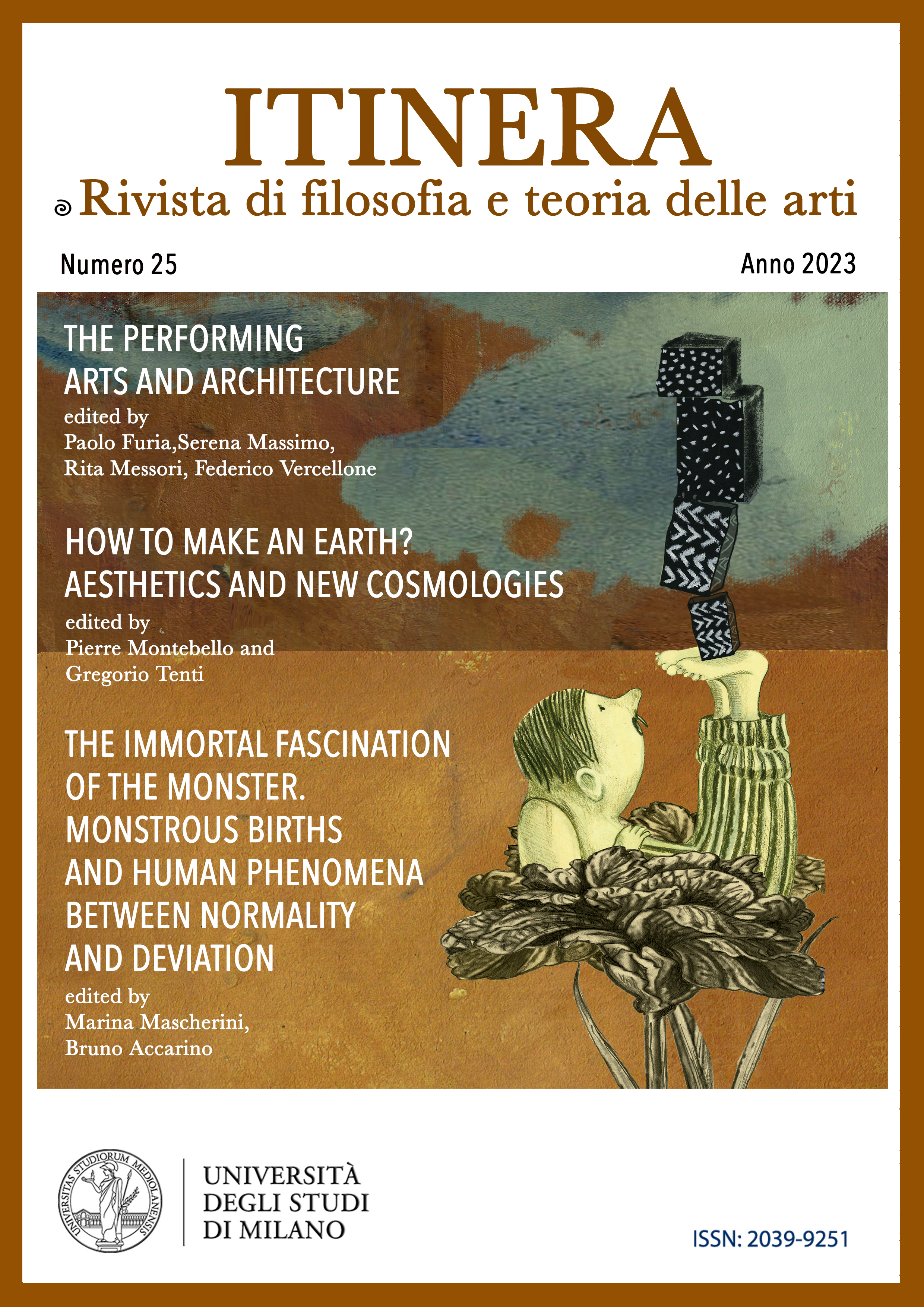Estetica della Terra Forma: quali strumenti per l’immaginazione Terrestre? La lezione di Bruno Latour
DOI:
https://doi.org/10.54103/2039-9251/20827Parole chiave:
LatourAbstract
Landing on Earth. This now famous formula, which appears in the title of the exhibition/catalogue Critical Zones. The Science and Politics of Landing on Earth, curated by Bruno Latour and Peter Weibel, sums up Latour’s ecological-political project and his attempt to respond to the Anthropocene’s need to bring us back to Earth, to this unstable soil that reacts to our actions and from which the project of Modernity had progressively distanced us. For Latour, climate change and the definition of anthropos as a geological force impose the search for a new habitable territory: the Earth we thought we knew, but which now presents itself as a new terra incognita. However, because of the uncertainty about the shape of the Earth, the need to develop new tools to orient ourselves and describe the situation in which we find ourselves becomes more and more urgent. If what is at stake after the disorientation (spatial, temporal, identity) caused by Gaia’s intrusion is the re-politicization of belonging to the land, what are the cartographic representations that will be able to effectively describe our co-belonging to the space we inhabit, helping to make visible the different chains of agency? What are the tools we can use to learn to see things differently and thus become more “sensitive and responsive” to the fragile shells of this metastable world where life forms other than our own intersect their paths? What kind of map is an earthly map?
Riferimenti bibliografici
Aït-Touati F., Arènes A., Grégoire A., Terra Forma. Manuel de cartographies potentielles, B42, Paris 2019.
Careri F., Walkscapes. Camminare come pratica estetica, Einaudi, Torino 2006.
Coccia E., La vita delle piante (2016), Il Mulino, Bologna 2018.
Croce M., Bruno Latour. Irriduzionismo | Attante | Piattezza | Ibridi | Gaia, DeriveApprodi, Roma 2020.
Deleuze G., La logica del senso (1969), tr. it. Mario de Stefanis, Feltrinelli, Milano 2015.
Engell L., Tasten, Wählen, Denken. Genese und Funktion einer philosophischen Apparatur in Medienphilosophie. Beiträge zur Klärung eines Begriffs, Fischer Taschenbuch Verlag, Frankfurt am Main 2003, pp. 53-77.
Gemenne F., Rankovic A., Atlante dell’Antropocene (2019), trad. it. di A. Malcevschi, Milano-Udine, Mimesis, 2021.
Latour B., Weibel P., Critical Zones. The Science and Politics of Landing on Earth, The MIT Press, London-Cambridge 2020.
Latour B., La Sfida di Gaia. Il Nuovo Regime Climatico (2015), Meltemi, Milano 2020.
Latour B., Seven Objections against Landing on Earth in B. Latour, P. Weibel (eds.) Critical Zones. The Science and Politics of Landing on Earth, The MIT Press, London-Cambridge 2020, pp. 12-19.
Latour B., Tracciare la rotta. Come orientarsi in politica (2017), Milano, Raffaello Cortina Editore, 2018.
Latour B., Non siamo mai stati moderni (1991), Elèuthera, Milano 2015.
Latour B, Anti-Zoom in Contact. Catalogue de l'exposition d'Olafur Eliasson, Paris, Fondation Vuitton, 2014, pp. 121-124.
Lowenhaupt Tsing A., Il fungo alla fine del mondo. La possibilità di vivere nelle rovine del capitalismo (2015), Keller editore, Rovereto 2021.
Horton Z., Cosmic Zoom. Scale Knowledge and Mediation, The University of Chicago Press, Chicago-London 2019.
Pievani T., Varotto M., Viaggio nell’Italia dell’Antropocene. La Geografia visionaria del nostro futuro, Aboca edizioni, Sansepolcro 2021.
Sloterdijk P., Il mondo dentro il capitale (2005), trad. it. di S. Rodeschini, Roma, Meltemi, 2006.
Stengers I., Nel tempo delle Catastrofi. Resistere alla barbarie a venire (2008), trad. it. di N. Manghi, Rosenberg & Sellier, Torino 2021.
Dowloads
Pubblicato
Versioni
- 2023-08-17 (4)
- 2023-08-17 (3)
- 2023-08-17 (2)
- 2023-08-08 (1)
Fascicolo
Sezione
Licenza
Copyright (c) 2023 Tommaso Morawski

Questo lavoro è fornito con la licenza Creative Commons Attribuzione - Condividi allo stesso modo 4.0.
Gli autori che pubblicano su questa rivista accettano le seguenti condizioni:
1. Gli autori mantengono i diritti sulla loro opera e cedono alla rivista il diritto di prima pubblicazione dell'opera, contemporaneamente licenziata sotto una Licenza Creative Commons - Attribuzione - Condividi allo stesso modo 4.0 internazionale che permette ad altri di condividere l'opera indicando la paternità intellettuale e la prima pubblicazione su questa rivista.
2. Gli autori possono aderire ad altri accordi di licenza non esclusiva per la distribuzione della versione dell'opera pubblicata (es. depositarla in un archivio istituzionale o pubblicarla in una monografia), a patto di indicare che la prima pubblicazione è avvenuta su questa rivista.
3. Gli autori possono diffondere la loro opera online (es. in repository istituzionali o nel loro sito web) prima e durante il processo di submission, poiché può portare a scambi produttivi e aumentare le citazioni dell'opera pubblicata (Vedi The Effect of Open Access).





